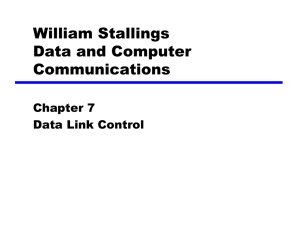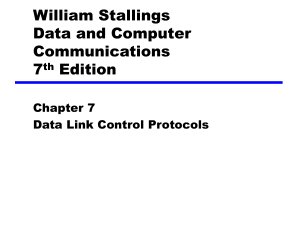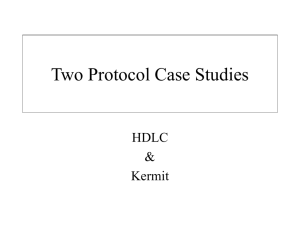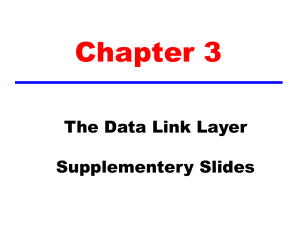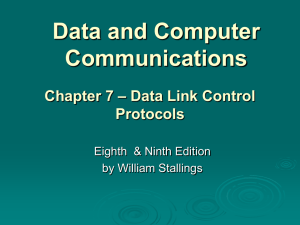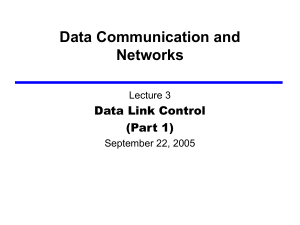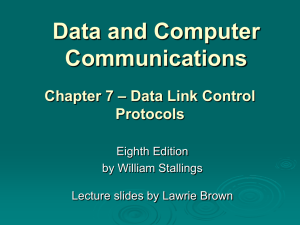chap07
advertisement
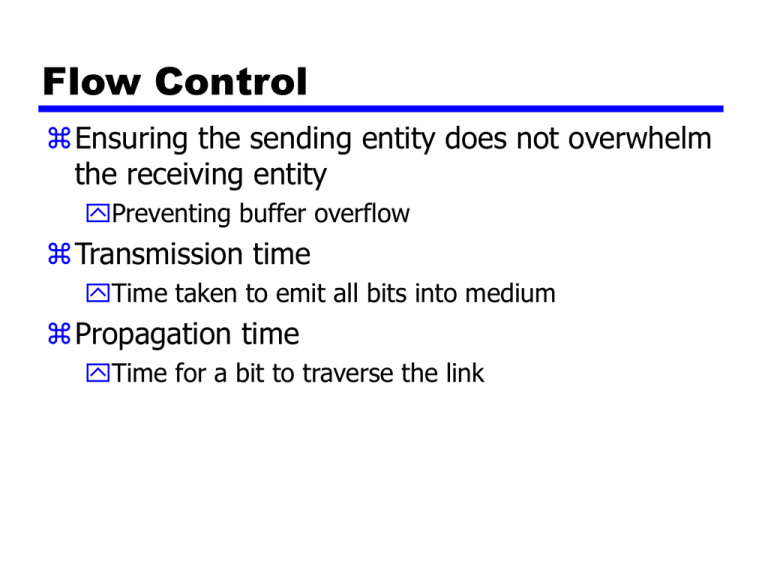
Flow Control Ensuring the sending entity does not overwhelm the receiving entity Preventing buffer overflow Transmission time Time taken to emit all bits into medium Propagation time Time for a bit to traverse the link Model of Frame Transmission Stop and Wait Source transmits frame Destination receives frame and replies with acknowledgement Source waits for ACK before sending next frame Destination can stop flow by not send ACK Works well for a few large frames Fragmentation Large block of data may be split into small frames Limited buffer size Errors detected sooner (when whole frame received) On error, retransmission of smaller frames is needed Prevents one station occupying medium for long periods Stop and wait becomes inadequate Stop and Wait Link Utilization Sliding Windows Flow Control Allow multiple frames to be in transit Receiver has buffer W long Transmitter can send up to W frames without ACK Each frame is numbered ACK includes number of next frame expected Sequence number bounded by size of field (k) Frames are numbered modulo 2k Sliding Window Diagram Example Sliding Window Sliding Window Enhancements Receiver can acknowledge frames without permitting further transmission (Receive Not Ready) Must send a normal acknowledge to resume If duplex, use piggybacking If no data to send, use acknowledgement frame If data but no acknowledgement to send, send last acknowledgement number again, or have ACK valid flag (TCP) Error Detection Additional bits added by transmitter for error detection code Parity Value of parity bit is such that character has even (even parity) or odd (odd parity) number of ones Even number of bit errors goes undetected Cyclic Redundancy Check For a block of k bits transmitter generates n bit sequence Transmit k+n bits which is exactly divisible by some number Receive divides frame by that number If no remainder, assume no error For math, see Stallings chapter 7 Error Control Detection and correction of errors Lost frames Damaged frames Automatic repeat request Error detection Positive acknowledgment Retransmission after timeout Negative acknowledgement and retransmission Automatic Repeat Request (ARQ) Stop and wait Go back N Selective reject (selective retransmission) Stop and Wait Source transmits single frame Wait for ACK If received frame damaged, discard it Transmitter has timeout If no ACK within timeout, retransmit If ACK damaged,transmitter will not recognize it Transmitter will retransmit Receive gets two copies of frame Use ACK0 and ACK1 Stop and Wait Diagram Stop and Wait - Pros and Cons Simple Inefficient Go Back N (1) Based on sliding window If no error, ACK as usual with next frame expected Use window to control number of outstanding frames If error, reply with rejection Discard that frame and all future frames until error frame received correctly Transmitter must go back and retransmit that frame and all subsequent frames Go Back N - Damaged Frame Receiver detects error in frame i Receiver sends rejection-i Transmitter gets rejection-i Transmitter retransmits frame i and all subsequent Go Back N - Lost Frame (1) Frame i lost Transmitter sends i+1 Receiver gets frame i+1 out of sequence Receiver send reject i Transmitter goes back to frame i and retransmits Go Back N - Lost Frame (2) Frame i lost and no additional frame sent Receiver gets nothing and returns neither acknowledgement nor rejection Transmitter times out and sends acknowledgement frame with P bit set to 1 Receiver interprets this as command which it acknowledges with the number of the next frame it expects (frame i ) Transmitter then retransmits frame i Go Back N - Damaged Acknowledgement Receiver gets frame i and send acknowledgement (i+1) which is lost Acknowledgements are cumulative, so next acknowledgement (i+n) may arrive before transmitter times out on frame i If transmitter times out, it sends acknowledgement with P bit set as before This can be repeated a number of times before a reset procedure is initiated Go Back N - Damaged Rejection As for lost frame (2) Go Back N Diagram Selective Reject Also called selective retransmission Only rejected frames are retransmitted Subsequent frames are accepted by the receiver and buffered Minimizes retransmission Receiver must maintain large enough buffer More complex login in transmitter Selective Reject Diagram High Level Data Link Control HDLC ISO 33009, ISO 4335 HDLC Station Types Primary station Controls operation of link Frames issued are called commands Maintains separate logical link to each secondary station Secondary station Under control of primary station Frames issued called responses Combined station May issue commands and responses HDLC Link Configurations Unbalanced One primary and one or more secondary stations Supports full duplex and half duplex Balanced Two combined stations Supports full duplex and half duplex HDLC Transfer Modes (1) Normal Response Mode (NRM) Unbalanced configuration Primary initiates transfer to secondary Secondary may only transmit data in response to command from primary Used on multi-drop lines Host computer as primary Terminals as secondary HDLC Transfer Modes (2) Asynchronous Balanced Mode (ABM) Balanced configuration Either station may initiate transmission without receiving permission Most widely used No polling overhead HDLC Transfer Modes (3) Asynchronous Response Mode (ARM) Unbalanced configuration Secondary may initiate transmission without permission form primary Primary responsible for line rarely used Frame Structure Synchronous transmission All transmissions in frames Single frame format for all data and control exchanges Frame Structure Diagram Flag Fields Delimit frame at both ends 01111110 May close one frame and open another Receiver hunts for flag sequence to synchronize Bit stuffing used to avoid confusion with data containing 01111110 0 inserted after every sequence of five 1s If receiver detects five 1s it checks next bit If 0, it is deleted If 1 and seventh bit is 0, accept as flag If sixth and seventh bits 1, sender is indicating abort Bit Stuffing Example with possible errors Address Field Identifies secondary station that sent or will receive frame Usually 8 bits long May be extended to multiples of 7 bits LSB of each octet indicates that it is the last octet (1) or not (0) All ones (11111111) is broadcast Control Field Different for different frame type Information - data to be transmitted to user (next layer up) Flow and error control piggybacked on information frames Supervisory - ARQ when piggyback not used Unnumbered - supplementary link control First one or two bits of control filed identify frame type Remaining bits explained later Control Field Diagram Poll/Final Bit Use depends on context Command frame P bit 1 to solicit (poll) response from peer Response frame F bit 1 indicates response to soliciting command Information Field Only in information and some unnumbered frames Must contain integral number of octets Variable length Frame Check Sequence Field FCS Error detection 16 bit CRC Optional 32 bit CRC HDLC Operation Exchange of information, supervisory and unnumbered frames Three phases Initialization Data transfer Disconnect Examples of Operation (1) Examples of Operation (2) Other DLC Protocols (LAPB,LAPD) Link Access Procedure, Balanced (LAPB) Part of X.25 (ITU-T) Subset of HDLC - ABM Point to point link between system and packet switching network node Link Access Procedure, D-Channel ISDN (ITU-D) ABM Always 7-bit sequence numbers (no 3-bit) 16 bit address field contains two sub-addresses One for device and one for user (next layer up) Other DLC Protocols (LLC) Logical Link Control (LLC) IEEE 802 Different frame format Link control split between medium access layer (MAC) and LLC (on top of MAC) No primary and secondary - all stations are peers Two addresses needed Sender and receiver Error detection at MAC layer 32 bit CRC Destination and source access points (DSAP, SSAP) Other DLC Protocols (Frame Relay) (1) Streamlined capability over high speed packet witched networks Used in place of X.25 Uses Link Access Procedure for Frame-Mode Bearer Services (LAPF) Two protocols Control - similar to HDLC Core - subset of control Other DLC Protocols (Frame Relay) (2) ABM 7-bit sequence numbers 16 bit CRC 2, 3 or 4 octet address field Data link connection identifier (DLCI) Identifies logical connection More on frame relay later Other DLC Protocols (ATM) Asynchronous Transfer Mode Streamlined capability across high speed networks Not HDLC based Frame format called “cell” Fixed 53 octet (424 bit) Details later Required Reading Stallings chapter 7 Web sites on HDLC, frame relay, Ethernet and ATM

